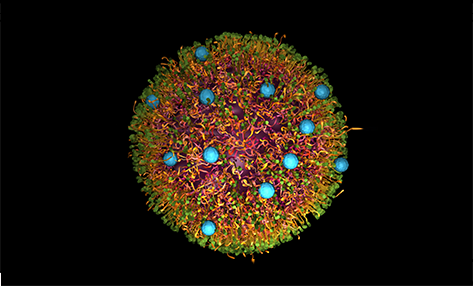Mr Bauer, what is the meaning of the name SmartDyeLivery, and what exactly are the aims ofthe company?
Michael Bauer: SmartDyeLivery is a pun and stands for the smart delivery of dye functionalised nanoparticles into the liver. The special feature of our technology is that it enables us to deliver nanoparticles loaded with theoretically any active ingredient specifically to particular organs or cells of the body. These nano transporters are applied systemically and pass the bloodstream until they come in contact with receptors recognising the respective functionalities. After binding to the target cell surface, the nanoparticle is completely incorporated into the cell. The nanoparticle then dissolves, whilst releasing the cargo. Then, the transported active ingredient is exclusively available for treatment at the targeted cell type. The aim is the organ-specific restoration of central cell functions, without damaging other tissues or functions by undesirable side effects.
What is special about nanotechnology?
Marc Lehmann: Nanotechnology, especially in the field of drug delivery systems, has developed rapidly over the past few years, and is now also being used in medicine. Nano-medicine, or more specifically nanoparticles in this case, have the potential to treat diseases in a more precise and targeted manner, minimizing or completely avoiding unwanted side-effects. In particular, approaches with distinct targeting moieties enable the transfer of the active ingredients to the organs or cells to be treated exclusively.
What is special about the company?
Michael Bauer: The technology of SmartDyeLivery GmbH is based on the comprehensive preliminary work of the Institute for Organic and Macromolecular Chemistry at the Friedrich-Schiller University and the Center for Sepsis Control and Care at the University Hospital of Jena, which finally led to the foundation of the company.
The very close cooperation between scientists and clinicians right from the beginning has to be emphasized. From a technical point of view our theranostic approach, i.e. the combination of diagnostics and therapy, is unique. By using the most modern imaging processes, such as opto-acoustic tomography, we can detect the delivery of the active ingredients into the cells and tissues over time as well as the organ function.
Why did you become a partner in the InfectoGnostics research campus?
Michael Bauer: Because InfectoGnostics is promoting a topic which is of outstanding importance: finding new methods in the diagnosis of infectious diseases. Only with improved diagnostics targeted treatment is possible resulting in better patient outcome. With regard to increasing antibiotic resistance in particular, as well as new possibilities in point-of-care diagnostics, we also need smart drug delivery systems usable for specific and targeted treatment. Based on delayed diagnostic results from microbiological testing broad spectrum antibiotics are still often administered today and therefore increasing the selection pressure on the microbes. This leads on the one hand to a spread of resistances, and on the other hand to serious side effects which could be avoided by precisely targeted delivery and the choice of a highly specific active ingredient. That is exactly where our technology will leverage its strengths. Although we initially concentrated on a specific clinical picture within the group of septic patients, we can use our nanoparticles also for different active ingredients and fields of application. For instance, it could be also possible to use nanoparticular formulations of active ingredients in the treatment of resistant micro-organisms, one of InfectoGnostic’s key topics.
In your opinion, what are the benefits of being a partner in the InfectoGnostics research campus?
Marc Lehmann: Most importantly the strong network created by the public-private partnership. Years of experience in the development of diagnostic and therapeutic systems show us how essential it is that scientists and physicians as well as academic groups and companies work closely together. You become more familiar with working methods, and can identify needs and challenges jointly. Therefore, the opportunity to work closely together with university facilities was a decisive factor for us in the decision becoming a part of the InfectoGnostics research campus. Since it is only together that we can bring newly developed technologies to market to improve patient’s outcome.
Introducing InfectoGnostics partner SmartDyeLivery
